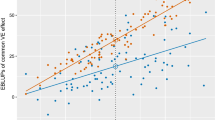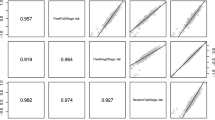Abstract
Of interest is the analysis of data resulting from a series of experiments repeated at several environments with the same set of plant varieties. Suppose that the experiments, multi-environment variety trials (as they are called), are all conducted in resolvable incomplete block designs. Adopting the randomization-derived mixed model obtained in Caliński et al. (Biometrics 61:448–455, 2005), a suitable analysis of variance methodology is considered and relevant test procedures are examined. The proposed methods are illustrated by the analysis of results of a series of trials with rye varieties.
Similar content being viewed by others
References
Bose RC (1942) A note on the resolvability of balanced incomplete block designs. Sankhyā 6: 105–110
Caliński T (2007) On some results of C. Radhakrishna Rao applicable to the analysis of multi-environment variety trials. J Stat Theory Pract 1: 347–356
Caliński T, Czajka S, Kaczmarek Z, Krajewski P, Pilarczyk W (2005) Analyzing multi-environment variety trials using randomization-derived mixed models. Biometrics 61: 448–455
Caliński T, Czajka S, Kaczmarek Z, Krajewski P, Pilarczyk W (2009) Analyzing the genotype by environment interactions under a randomization-derived mixed model. J Agric Biol Environ Stat 14: 224–241
Denis J-B, Piepho H-P, van Eeuwijk FA (1997) Modelling expectation and variance for genotype by environment data. Heredity 79: 162–171
Gogel BJ, Cullis BR, Verbyla AP (1995) REML estimation of multiplicative effects in multi-environment variety trials. Biometrics 51: 744–749
Houtman AM, Speed TP (1983) Balance in designed experiments with orthogonal block structure. Ann Stat 11: 1069–1085
John JA (1987) Cyclic designs. Chapman and Hall, London
John JA, Williams ER (1995) Cyclic and computer generated designs, 2nd edn. Chapman and Hall, London
Nelder JA (1954) The interpretation of negative components of variance. Biometrika 41: 544–548
Nelder JA (1965) The analysis of randomized experiments with orthogonal block structure. Proc R Soc Ser A 283: 147–178
Nelder JA (1968) The combination of information in generally balanced designs. J R Stat Soc Ser B 30: 303–311
Patterson HD, Silvey V (1980) Statutory and recommended list trials of crop varieties in the United Kingdom (with discussion). J R Stat Soc Ser A 143: 219–252
Patterson HD, Thompson R (1975) Maximum likelihood estimation of components of variance. In: Corsten LCA, Postelnicu T (eds) Proceedings of the 8th international biometric conference. Editura Academiei, Bucureşti, pp 197–207
Patterson HD, Williams ER (1976) A new class of resolvable incomplete block designs. Biometrika 63: 83–92
Patterson HD, Williams ER, Hunter EA (1978) Block designs for variety trials. J Agric Sci Cambridge 90: 395–400
Rao CR (1971) Estimation of variance and covariance components—MINQUE theory. J Multivar Anal 1: 257–275
Rao CR (1971) Unified theory of linear estimation. Sankhyā, Ser A 33: 371–394
Rao CR (1972) Estimation of variance and covariance components in linear models. J Am Stat Assoc 67: 112–115
Rao CR (1973) Representations of best linear unbiased estimators in the Gauss-Markoff model with a singular dispersion matrix. J Multivar Anal 3: 276–292
Rao CR (1979) MINQUE theory and its relation to ML and MML estimation of variance components. Sankhyā, Ser B 41: 138–153
Rao CR, Kleffe J (1988) Estimation of variance components and applications. North-Holland, Amsterdam
Rao CR, Mitra SK (1971) Generalized inverse of matrices and its applications. Wiley, New York
Smith A, Cullis B, Gilmour A (2001a) The analysis of crop variety evaluation data in Australia. Aust New Zealand J Stat 43: 129–145
Smith A, Cullis B, Thompson R (2001b) Analyzing variety by environment data using multiplicative mixed models and adjustments for spatial field trend. Biometrics 57: 1138–1147
Smith AB, Cullis BR, Thompson R (2005) The analysis of crop cultivar breeding and evaluation trials: an overview of current mixed model approaches. J Agric Sci 143: 449–462
Williams ER (1977) Iterative analysis of generalized lattice designs. Aust J Stat 19: 39–42
Yates F, Cochran WG (1938) The analysis of groups of experiments. J Agric Sci 28: 556–580
Author information
Authors and Affiliations
Corresponding author
Rights and permissions
About this article
Cite this article
Caliński, T., Czajka, S., Kaczmarek, Z. et al. A mixed model analysis of variance for multi-environment variety trials. Stat Papers 50, 735–759 (2009). https://doi.org/10.1007/s00362-009-0249-1
Received:
Accepted:
Published:
Issue Date:
DOI: https://doi.org/10.1007/s00362-009-0249-1
Keywords
- Analysis of variance
- Estimation
- Hypothesis testing
- Mixed effects model
- Series of experiments
- Variety by environment interactions




